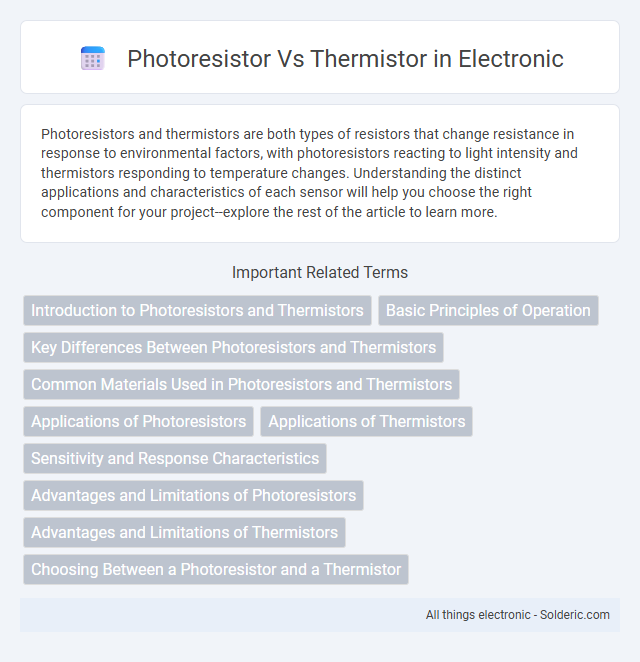Photoresistors and thermistors are both types of resistors that change resistance in response to environmental factors, with photoresistors reacting to light intensity and thermistors responding to temperature changes. Understanding the distinct applications and characteristics of each sensor will help you choose the right component for your project--explore the rest of the article to learn more.
Comparison Table
| Feature | Photoresistor (LDR) | Thermistor |
|---|---|---|
| Primary Function | Measures light intensity | Measures temperature |
| Sensing Element | Semiconductor material sensitive to light | Semiconductor material sensitive to temperature |
| Resistance Behavior | Decreases resistance with increased light | NTC: resistance decreases with temperature; PTC: resistance increases with temperature |
| Common Types | Cadmium Sulfide (CdS) LDR | NTC (Negative Temperature Coefficient), PTC (Positive Temperature Coefficient) |
| Response Time | Slow (milliseconds to seconds) | Fast to moderate (milliseconds) |
| Applications | Light meters, street lamps, camera exposure controls | Temperature sensors, thermostats, battery packs |
| Operating Range | Depends on light intensity (lux scale) | Wide temperature range (typically -50degC to 150degC) |
| Advantages | Simple, low cost, good for ambient light detection | Accurate temperature measurement, fast response |
| Limitations | Slow response, less accurate in low light | Non-linear response, may require calibration |
Introduction to Photoresistors and Thermistors
Photoresistors and thermistors are types of resistors that respond to environmental changes, with photoresistors reacting to light intensity and thermistors to temperature variations. These components are essential in sensors and circuits where detecting light or temperature changes is critical for functionality. Your choice between them depends on whether your application requires sensitivity to light or heat for accurate measurement and control.
Basic Principles of Operation
A photoresistor operates by changing its electrical resistance based on the intensity of light; its resistance decreases as the light intensity increases due to the generation of charge carriers in the semiconductor material. A thermistor functions by altering its resistance in response to temperature variations; negative temperature coefficient (NTC) thermistors decrease resistance with rising temperature, while positive temperature coefficient (PTC) thermistors increase resistance. Both devices rely on material properties that vary with physical stimuli--light for photoresistors and heat for thermistors--making them essential for sensing applications in electronics.
Key Differences Between Photoresistors and Thermistors
Photoresistors detect changes in light intensity while thermistors respond to temperature variations, making their primary sensing mechanisms distinct. Photoresistors typically have slower response times compared to thermistors, which often provide rapid and precise temperature readings. Your choice between these sensors depends on whether you need to measure light levels or temperature in your application.
Common Materials Used in Photoresistors and Thermistors
Photoresistors commonly use cadmium sulfide (CdS) or cadmium selenide (CdSe) as their semiconductor materials, enabling them to detect changes in light intensity effectively. Thermistors primarily consist of metal oxides such as manganese, cobalt, nickel, or iron oxides, which provide accurate sensitivity to temperature variations. When selecting components for your project, consider these material differences to optimize sensor performance based on whether light or temperature measurement is needed.
Applications of Photoresistors
Photoresistors are primarily used in light-sensing applications such as automatic street lighting, alarm systems, and light meters for photography. These devices respond to changes in ambient light intensity, making them ideal for energy-saving applications like adjusting screen brightness in smartphones and laptops. Their simple operation and cost-effectiveness also support use in solar garden lamps and light-activated switches.
Applications of Thermistors
Thermistors are widely used in temperature sensing applications such as HVAC systems, automotive temperature monitoring, and medical devices due to their high sensitivity and fast response time. They serve as precise temperature sensors in digital thermometers, battery packs, and home appliances to ensure optimal performance and safety. Their ability to provide accurate temperature feedback makes them essential components in temperature control circuits and overheat protection systems.
Sensitivity and Response Characteristics
Photoresistors exhibit high sensitivity to changes in light intensity with a relatively slow response time ranging from milliseconds to seconds, making them suitable for ambient light sensing applications. Thermistors demonstrate rapid response rates in the order of milliseconds to temperature variations with exceptional sensitivity, often measured in degrees Celsius per resistance change, ideal for precise temperature monitoring. Both sensor types leverage material properties to convert physical stimuli into electrical resistance changes, yet their response dynamics and sensitivity thresholds differ significantly based on their operational contexts.
Advantages and Limitations of Photoresistors
Photoresistors offer the advantage of simple and cost-effective light sensing with a fast response time, making them ideal for applications like light meters and automatic lighting controls. Their main limitation lies in their sensitivity to temperature variations and lower precision compared to photodiodes, which can affect measurement accuracy. When choosing a sensor, your decision should consider the balance between affordability and the specific light sensitivity requirements of your project.
Advantages and Limitations of Thermistors
Thermistors offer high sensitivity and precise temperature measurement, making them ideal for applications requiring accurate thermal monitoring, such as medical devices and HVAC systems. Their limitations include a narrow temperature range and non-linear response, which necessitates calibration and compensation for accurate readings in varying conditions. Unlike photoresistors that measure light intensity, thermistors specifically respond to temperature changes, providing reliable thermal data but lacking versatility for non-thermal sensing.
Choosing Between a Photoresistor and a Thermistor
Choosing between a photoresistor and a thermistor depends on whether your project requires sensing light intensity or temperature changes. Photoresistors respond to varying light levels by altering resistance, making them ideal for light detection applications, whereas thermistors change resistance with temperature fluctuations, suited for thermal monitoring. Your decision should align with the specific environmental parameter you need to measure accurately.
Photoresistor vs thermistor Infographic

 solderic.com
solderic.com